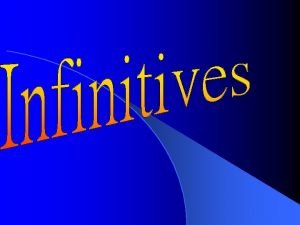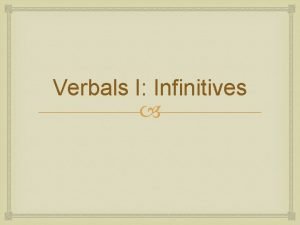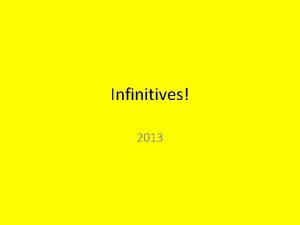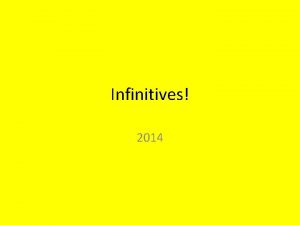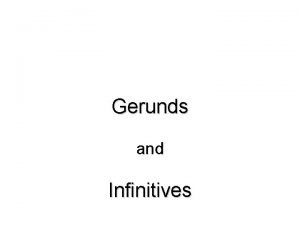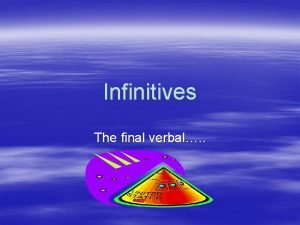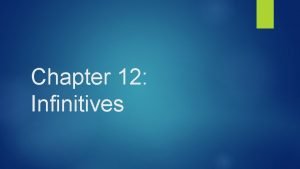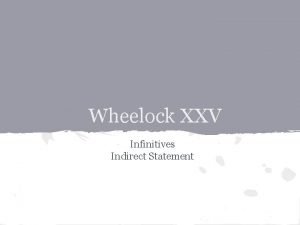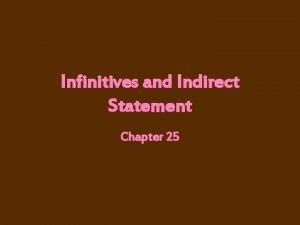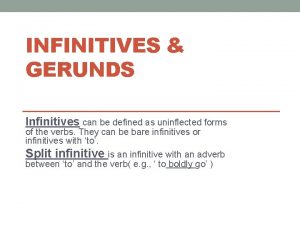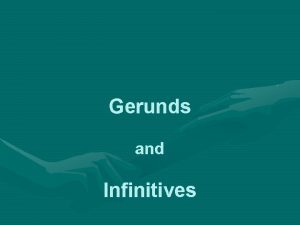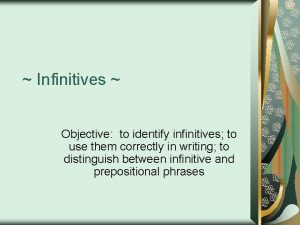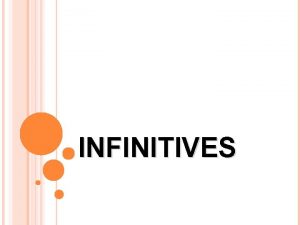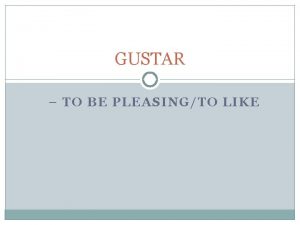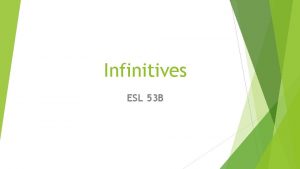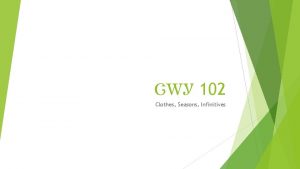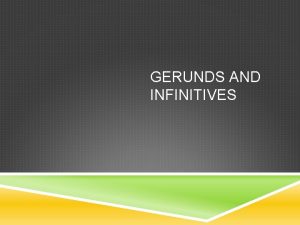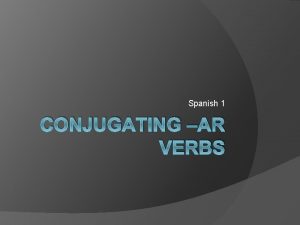Part One THE TYPES OF INFINITIVES What are





































- Slides: 37


Part One: THE TYPES OF INFINITIVES

What are Infinitives? The infinitive is the form of the verb not changed for persons, number or tense.

A. To-infinitives It is usually, but not always, used with the particle 'to’ in front it. A. They can function as subjects of sentences. e. g. To play the piano well requires a good sense of music. To go on a trip is very relaxing.

B. In modern usage, it is more common to begin the sentence with “it”. e. g. It requires a good sense of music to play the piano well. It is very relaxing to go on a trip. It is very important for students to study hard.

C. To-infinitives can directly follow some verbs, such as ASK, BEG, EXPECT, BEGIN, DECIDE, MANAGE, LIKE, WANT, TRY, WISH, PURPOSE, HOPE. e. g. I intend to study Biology at university. She hopes to win the lottery. He decided to join the English Club at school.

D. To-infinitives can be used after an object. e. g. Peter asked me to take his sister home. Mother advised Tom to think carefully before he made his decision. The teacher did not allow students to shout in class.

E. To-infinitives can be used with question words like HOW , WHERE , WHAT and WHEN. e. g. I asked him how to get to the railway station. We are discussing where to go for our holidays. Please tell me when to take the cake out of the oven.

B. Bare Infinitive The infinitive is sometimes used without the particle 'to'. This is called the 'bare' infinitive. The 'bare' infinitive is used:

A. After WILL (WOULD), SHALL (SHOULD), CAN (COULD), MAY (MIGHT), DO (DOES, DID) and MUST. e. g. She does not care for tennis. He could not get the ticket for the concert.

B. After verbs of perception (SEE, WATCH, NOTICE, OBSERVE, HEAR, LISTEN, FEEL and SMELL) e. g. I watched the children play with their new electronic game. He heard somebody shout for help.

C. After the verbs MAKE and LET. e. g. Let him come in now. The robbers made the manager open the safe. D. After HAD BETTER, WOULD RATHER, CANNOT BUT, CAN DO , NOTHING BUT. e. g. You had better go and see the doctor at once. They would rather try and fail than give up.

E. After HELP e. g. Shall I help you carry your luggage? F. After BID e. g. The managers bade him go in. G. After NEED and DARE when they are used as special verbs. e. g. You need not worry about her. He dared not tell anybody his secret.

H. In the construction HAVE SOMEBODY DO SOMETHING. e. g. The manager said, ' I'll have my secretary type the letter at once. ' I. After EXCEPT e. g. There is nothing I can do except wait for their reply.

Part Two: THE FORMS OF INFINITIVES

Five forms of infinitive Infinitive active passive simple prefect continuous simple perfect

1 a. Simple form ( Active ) The simple form of infinitive is used when 1. The action denoted by the infinitive and the action denoted by the main verb take place at the same time or almost at the same time. e. g. We are sorry to hear of your father’s death.

2. The action expressed by the infinitive takes place after the action expressed by the main verb. e. g. I intend to have a medical check-up some time next week.

1 b. Perfect form ( Active ) If the action expressed by the infinitive takes place before the action expressed by the main verb, the prefect of the infinitive should be used. e. g. I am sorry to have kept you waiting.

1 c. Continuous form When the action-donated by the infinitive is going on at the time the action of the main verb , we use the continuous form. e. g. They are likely to be waiting for us at the station now.

2. Passive form We use the passive form of the infinitive when the logical subject of the action expressed by the infinitive is not the doer of the action. Simple form e. g. 1 The books are not allowed to be taken out of the reference library. Compare: You are not allowed to take the books out of the reference library.

Prefect form e. g. 2 The book is said to have been translated into Chinese. Compare: He is said to have translated the book into Chinese.

The negative is formed by adding the word NOT before the infinitive. e. g. Mother told us not to tell lies.

Part Three: THE USAGE OF INFINITIVES

The infinitives can be used: v v v v as nouns as adverbs as adjectives after adjectives to form a number of useful patterns in absolute construction to make a sentence simpler and shorter to avoid repetition

A. as noun 1. as subject e. g. To stay up late is bad for the health. 2. as object e. g. He promised to give us a hand. 3. as complement e. g. This flat is to let.

4. with HOW, WHEN, WHERE, WHY, WHAT, WHICH, etc. , as: a. subject e. g. How to remedy the deterioting situation will be discussed at the next meeting. b. object e. g. Can you advise us where to go? c. complement e. g. The question is when to start the repair work.

B. as adjective e. g. I have a lot of work to do tomorrow.

C. The infinitive is used after adjectives to form a number of useful patterns: 1) with adjectives expressing emotion or desire (sorry, glad, afraid, willing, etc. ) e. g. We shall be happy to accept your offer.

2) with past participles (pleased, delighted, disappointed, etc. ) e. g. She is delighted to hear that you have recovered. 3) with adjectives of personal qualities (kind, bad, good, naughty, etc. ) e. g. You are very kind to ask after my parents.

4) with impersonal adjectives (necessary, dangerous, easy, hard, etc. ) e. g. It is impossible for us to finish the work before dusk. 5) with some other adjectives like READY, FIT, SURE, CERTAIN, ABLE, UNABLE, etc. e. g. The water from this well is not fit to drink.

D. as adverbs: 1) to express purpose e. g. She is working hard in order to pass the examination. 2) to express result e. g. He is too young to go to school.

3) to express reason e. g. He shuddered to think of his possible failure. 4) to indicate a subsequent fact e. g. He awoke to find the house on fire.

E. in absolute construction e. g. To tell you the truth, I don’t think the plan will work. To be fair, he is not the only person that is to blame.

F. It is often to make a sentence simpler and shorter e. g. 1. I have something that I must tell you. I have something to tell you. e. g. 2. I wonder where I can find him. I wonder where to find him.

G. To avoid repetition e. g. X: Would you like to have tea with us? Y: Oh, I’d love to.

Part 1: Wong Yuk Hung (27) Part 2: Yui Ka Yee (30) Part 3: Lin Lai Miu (14)
 Insidan region jh
Insidan region jh Gerunds infinitives and participles are types of
Gerunds infinitives and participles are types of The bare infinitive
The bare infinitive One god one empire one emperor
One god one empire one emperor One one one little puppy run
One one one little puppy run One king one law one faith
One king one law one faith One god one empire one emperor
One god one empire one emperor One ford plan
One ford plan See one do one teach one
See one do one teach one One price policy
One price policy Twelfth night speeches
Twelfth night speeches See one do one teach one
See one do one teach one Asean tourism strategic plan
Asean tourism strategic plan Graphic organizer with the aims of la liga filipina
Graphic organizer with the aims of la liga filipina Hình ảnh bộ gõ cơ thể búng tay
Hình ảnh bộ gõ cơ thể búng tay Lp html
Lp html Bổ thể
Bổ thể Tỉ lệ cơ thể trẻ em
Tỉ lệ cơ thể trẻ em Chó sói
Chó sói Chụp phim tư thế worms-breton
Chụp phim tư thế worms-breton Chúa yêu trần thế alleluia
Chúa yêu trần thế alleluia Môn thể thao bắt đầu bằng chữ đua
Môn thể thao bắt đầu bằng chữ đua Thế nào là hệ số cao nhất
Thế nào là hệ số cao nhất Các châu lục và đại dương trên thế giới
Các châu lục và đại dương trên thế giới Cong thức tính động năng
Cong thức tính động năng Trời xanh đây là của chúng ta thể thơ
Trời xanh đây là của chúng ta thể thơ Mật thư anh em như thể tay chân
Mật thư anh em như thể tay chân Làm thế nào để 102-1=99
Làm thế nào để 102-1=99 Phản ứng thế ankan
Phản ứng thế ankan Các châu lục và đại dương trên thế giới
Các châu lục và đại dương trên thế giới Thể thơ truyền thống
Thể thơ truyền thống Quá trình desamine hóa có thể tạo ra
Quá trình desamine hóa có thể tạo ra Một số thể thơ truyền thống
Một số thể thơ truyền thống Bàn tay mà dây bẩn
Bàn tay mà dây bẩn Vẽ hình chiếu vuông góc của vật thể sau
Vẽ hình chiếu vuông góc của vật thể sau Nguyên nhân của sự mỏi cơ sinh 8
Nguyên nhân của sự mỏi cơ sinh 8 đặc điểm cơ thể của người tối cổ
đặc điểm cơ thể của người tối cổ Thế nào là giọng cùng tên?
Thế nào là giọng cùng tên?


